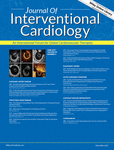Balloon aortic valvuloplasty in contemporary practice
Abstract
Background
There has been a revival of balloon aortic valvuloplasty (BAV) for severe aortic stenosis, as a result of an increasing number of patients undergoing trans-catheter aortic valve implantation (TAVI). However, there has not been universal adoption of BAV as a standalone, nor bridging therapy.
Methods
A retrospective analysis of the practice at our institution between June 2009 and May 2016 was performed. Demographic, clinical, procedural, and follow-up data on all patients were collected.
Results
A total of 200 patients with a median age of 82 years and severe symptomatic aortic stenosis underwent BAV from June 2009 to May 2016. All patients had appreciable comorbidity with a mean logistic Euro SCORE of 48 ± 11 and mean standard Euro SCORE 15 ± 4. BAV was performed for palliation in 118 (59%), as a bridging therapy for TAVI in 55 (27.5%) and bridging to surgical AVR in 27 patients (13.5%), respectively. Major complications occurred in 14 patients (7%) including 2 in-patient deaths (1%). A statistically significant improvement in symptoms and a decrease in trans-valvular gradient were observed.
Conclusion
BAV is an effective treatment strategy, either as a bridge to definitive therapy or as a palliative procedure, with an acceptable mortality. BAV is associated with a significant improvement in symptoms and is valuable as a palliative treatment in high-risk patients, where no other invasive option is available.




